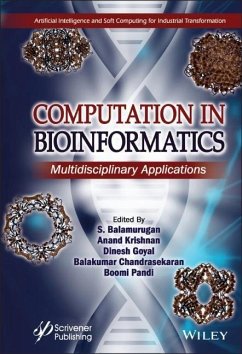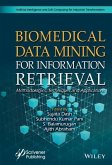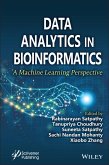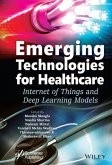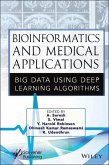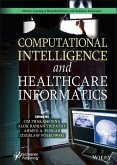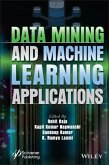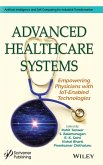S BalamuruganMultidisciplinary Applications
Computation in Bioinformatics
Multidisciplinary Applications
Herausgegeben:Balamurugan, S.; Krishnan, Anand T.; Goyal, Dinesh; Chandrasekaran, Balakumar
S BalamuruganMultidisciplinary Applications
Computation in Bioinformatics
Multidisciplinary Applications
Herausgegeben:Balamurugan, S.; Krishnan, Anand T.; Goyal, Dinesh; Chandrasekaran, Balakumar
- Gebundenes Buch
- Merkliste
- Auf die Merkliste
- Bewerten Bewerten
- Teilen
- Produkt teilen
- Produkterinnerung
- Produkterinnerung
Die Bioinformatik ist ein Feld zwischen der Biologie und der Informationstechnologie. Das Werk deckt zahlreiche Gebiete der Bioinformatik ab, beginnend mit den grundlegenden Prinzipien, Konzepten und multidisziplinären Anwendungsbereichen. Es enthält eine Reihe von Kapiteln, in denen die Rolle der Bioinformatik bei der Entwicklung und Entdeckung von Arzneimitteln beschrieben wird, insbesondere in Bezug auf die molekulare Modellierung. In anderen Kapiteln werden Themen wie in-silico-Design, Proteinmodellierung, DNA-Mikroarray-Analyse, DNA-RNA-Barcoding und Gensequenzierung ausführlich…mehr
Andere Kunden interessierten sich auch für
![Biomedical Data Mining for Information Retrieval Biomedical Data Mining for Information Retrieval]() Biomedical Data Mining for Information Retrieval214,99 €
Biomedical Data Mining for Information Retrieval214,99 €![Data Analytics in Bioinformatics Data Analytics in Bioinformatics]() R SatapathyData Analytics in Bioinformatics209,99 €
R SatapathyData Analytics in Bioinformatics209,99 €![Emerging Technologies for Healthcare Emerging Technologies for Healthcare]() M ManglaEmerging Technologies for Healthcare214,99 €
M ManglaEmerging Technologies for Healthcare214,99 €![Bioinformatics and Medical Applications Bioinformatics and Medical Applications]() A SureshBioinformatics and Medical Applications214,99 €
A SureshBioinformatics and Medical Applications214,99 €![Computational Intelligence and Healthcare Informatics Computational Intelligence and Healthcare Informatics]() OP JenaComputational Intelligence and Healthcare Informatics216,99 €
OP JenaComputational Intelligence and Healthcare Informatics216,99 €![Data Mining and Machine Learning Applications Data Mining and Machine Learning Applications]() R RajaData Mining and Machine Learning Applications214,99 €
R RajaData Mining and Machine Learning Applications214,99 €![Advanced Healthcare Systems Advanced Healthcare Systems]() Rohit TanwarAdvanced Healthcare Systems214,99 €
Rohit TanwarAdvanced Healthcare Systems214,99 €-
-
-
Die Bioinformatik ist ein Feld zwischen der Biologie und der Informationstechnologie. Das Werk deckt zahlreiche Gebiete der Bioinformatik ab, beginnend mit den grundlegenden Prinzipien, Konzepten und multidisziplinären Anwendungsbereichen. Es enthält eine Reihe von Kapiteln, in denen die Rolle der Bioinformatik bei der Entwicklung und Entdeckung von Arzneimitteln beschrieben wird, insbesondere in Bezug auf die molekulare Modellierung. In anderen Kapiteln werden Themen wie in-silico-Design, Proteinmodellierung, DNA-Mikroarray-Analyse, DNA-RNA-Barcoding und Gensequenzierung ausführlich behandelt. Und schließlich widmen sich einige Kapitel speziellen Themen wie der Nutzung der Bioinformatik in der Krebserkennung, Genomik, Proteomik, beim maschinellen Lernen sowie bei kovalenten Ansätzen in der Entwicklung von Arzneimitteln.
Produktdetails
- Produktdetails
- Verlag: Wiley & Sons / Wiley-Scrivener
- Artikelnr. des Verlages: 1W119654710
- 1. Auflage
- Seitenzahl: 352
- Erscheinungstermin: 19. Oktober 2021
- Englisch
- Abmessung: 237mm x 163mm x 23mm
- Gewicht: 620g
- ISBN-13: 9781119654711
- ISBN-10: 1119654718
- Artikelnr.: 59545514
- Herstellerkennzeichnung
- Libri GmbH
- Europaallee 1
- 36244 Bad Hersfeld
- gpsr@libri.de
- Verlag: Wiley & Sons / Wiley-Scrivener
- Artikelnr. des Verlages: 1W119654710
- 1. Auflage
- Seitenzahl: 352
- Erscheinungstermin: 19. Oktober 2021
- Englisch
- Abmessung: 237mm x 163mm x 23mm
- Gewicht: 620g
- ISBN-13: 9781119654711
- ISBN-10: 1119654718
- Artikelnr.: 59545514
- Herstellerkennzeichnung
- Libri GmbH
- Europaallee 1
- 36244 Bad Hersfeld
- gpsr@libri.de
S. Balamurugan, PhD is the Director of Research and Development, Intelligent Research Consultancy Services (iRCS), Coimbatore, Tamilnadu, India. His PhD is in Information Technology, and he has published 45 books, 200+ international journals/conferences, and 35 patents. Anand Krishnan, PhD is the NRF-DSI Innovation Fellow, Department of Chemical Pathology, University of the Free State (Bloemfontein Campus), Bloemfontein, South Africa. His expertise is in organic chemistry/medical biochemistry/integrative medicine/nano(bio)technology/drug discovery. Dinesh Goyal, PhD is the Director at the Poornima Institute of Engineering and Technology, Jaipur, India. His research interests are related to information & network security, image processing, data analytics, and cloud computing. Balakumar Chandrasekaran, PhD is an assistant professor at the Faculty of Pharmacy, Philadelphia University, Jordan. He has published many research articles and book chapters as well as two patents. Boomi Pandi, PhD is an assistant professor in the Department of Bioinformatics, Alagappa University, Karaikudi, India. He has a number of international articles to his credit. Among his research interest are nanomaterials and polymer synthesis, bio-inorganic chemistry, and nano-drug delivery.
Preface xiii
1 Bioinfomatics as a Tool in Drug Designing 1
Rene Barbie Browne, Shiny C. Thomas and Jayanti Datta Roy
1.1 Introduction 1
1.2 Steps Involved in Drug Designing 3
1.2.1 Identification of the Target Protein/Enzyme 5
1.2.2 Detection of Molecular Site (Active Site) in the Target Protein 6
1.2.3 Molecular Modeling 6
1.2.4 Virtual Screening 9
1.2.5 Molecular Docking 10
1.2.6 QSAR (Quantitative Structure-Activity Relationship) 12
1.2.7 Pharmacophore Modeling 14
1.2.8 Solubility of Molecule 14
1.2.9 Molecular Dynamic Simulation 14
1.2.10 ADME Prediction 15
1.3 Various Softwares Used in the Steps of Drug Designing 16
1.4 Applications 18
1.5 Conclusion 20
References 20
2 New Strategies in Drug Discovery 25
Vivek Chavda, Yogita Thalkari and Swati Marwadi
2.1 Introduction 26
2.2 Road Toward Advancement 27
2.3 Methodology 30
2.3.1 Target Identification 30
2.3.2 Docking-Based Virtual Screening 32
2.3.3 Conformation Sampling 33
2.3.4 Scoring Function 34
2.3.5 Molecular Similarity Methods 35
2.3.6 Virtual Library Construction 37
2.3.7 Sequence-Based Drug Design 37
2.4 Role of OMICS Technology 38
2.5 High-Throughput Screening and Its Tools 40
2.6 Chemoinformatic 44
2.6.1 Exploratory Data Analysis 45
2.6.2 Example Discovery 46
2.6.3 Pattern Explanation 46
2.6.4 New Technologies 46
2.7 Concluding Remarks and Future Prospects 46
References 48
3 Role of Bioinformatics in Early Drug Discovery: An Overview and Perspective 49
Shasank S. Swain and Tahziba Hussain
3.1 Introduction 50
3.2 Bioinformatics and Drug Discovery 51
3.2.1 Structure-Based Drug Design (SBDD) 52
3.2.2 Ligand-Based Drug Design (LBDD) 53
3.3 Bioinformatics Tools in Early Drug Discovery 54
3.3.1 Possible Biological Activity Prediction Tools 55
3.3.2 Possible Physicochemical and Drug-Likeness Properties Verification Tools 58
3.3.3 Possible Toxicity and ADME/T Profile Prediction Tools 60
3.4 Future Directions With Bioinformatics Tool 61
3.5 Conclusion 63
Acknowledgements 64
References 64
4 Role of Data Mining in Bioinformatics 69
Vivek P. Chavda, Amit Sorathiya, Disha Valu and Swati Marwadi
4.1 Introduction 70
4.2 Data Mining Methods/Techniques 71
4.2.1 Classification 71
4.2.1.1 Statistical Techniques 71
4.2.1.2 Clustering Technique 73
4.2.1.3 Visualization 74
4.2.1.4 Induction Decision Tree Technique 74
4.2.1.5 Neural Network 75
4.2.1.6 Association Rule Technique 75
4.2.1.7 Classification 75
4.3 DNA Data Analysis 77
4.4 RNA Data Analysis 79
4.5 Protein Data Analysis 79
4.6 Biomedical Data Analysis 80
4.7 Conclusion and Future Prospects 81
References 81
5 In Silico Protein Design and Virtual Screening 85
Vivek P. Chavda, Zeel Patel, Yashti Parmar and Disha Chavda
5.1 Introduction 86
5.2 Virtual Screening Process 88
5.2.1 Before Virtual Screening 90
5.2.2 General Process of Virtual Screening 90
5.2.2.1 Step 1 (The Establishment of the Receptor Model) 91
5.2.2.2 Step 2 (The Generation of Small-Molecule Libraries) 92
5.2.2.3 Step 3 (Molecular Docking) 92
5.2.2.4 Step 4 (Selection of Lead Prot
1 Bioinfomatics as a Tool in Drug Designing 1
Rene Barbie Browne, Shiny C. Thomas and Jayanti Datta Roy
1.1 Introduction 1
1.2 Steps Involved in Drug Designing 3
1.2.1 Identification of the Target Protein/Enzyme 5
1.2.2 Detection of Molecular Site (Active Site) in the Target Protein 6
1.2.3 Molecular Modeling 6
1.2.4 Virtual Screening 9
1.2.5 Molecular Docking 10
1.2.6 QSAR (Quantitative Structure-Activity Relationship) 12
1.2.7 Pharmacophore Modeling 14
1.2.8 Solubility of Molecule 14
1.2.9 Molecular Dynamic Simulation 14
1.2.10 ADME Prediction 15
1.3 Various Softwares Used in the Steps of Drug Designing 16
1.4 Applications 18
1.5 Conclusion 20
References 20
2 New Strategies in Drug Discovery 25
Vivek Chavda, Yogita Thalkari and Swati Marwadi
2.1 Introduction 26
2.2 Road Toward Advancement 27
2.3 Methodology 30
2.3.1 Target Identification 30
2.3.2 Docking-Based Virtual Screening 32
2.3.3 Conformation Sampling 33
2.3.4 Scoring Function 34
2.3.5 Molecular Similarity Methods 35
2.3.6 Virtual Library Construction 37
2.3.7 Sequence-Based Drug Design 37
2.4 Role of OMICS Technology 38
2.5 High-Throughput Screening and Its Tools 40
2.6 Chemoinformatic 44
2.6.1 Exploratory Data Analysis 45
2.6.2 Example Discovery 46
2.6.3 Pattern Explanation 46
2.6.4 New Technologies 46
2.7 Concluding Remarks and Future Prospects 46
References 48
3 Role of Bioinformatics in Early Drug Discovery: An Overview and Perspective 49
Shasank S. Swain and Tahziba Hussain
3.1 Introduction 50
3.2 Bioinformatics and Drug Discovery 51
3.2.1 Structure-Based Drug Design (SBDD) 52
3.2.2 Ligand-Based Drug Design (LBDD) 53
3.3 Bioinformatics Tools in Early Drug Discovery 54
3.3.1 Possible Biological Activity Prediction Tools 55
3.3.2 Possible Physicochemical and Drug-Likeness Properties Verification Tools 58
3.3.3 Possible Toxicity and ADME/T Profile Prediction Tools 60
3.4 Future Directions With Bioinformatics Tool 61
3.5 Conclusion 63
Acknowledgements 64
References 64
4 Role of Data Mining in Bioinformatics 69
Vivek P. Chavda, Amit Sorathiya, Disha Valu and Swati Marwadi
4.1 Introduction 70
4.2 Data Mining Methods/Techniques 71
4.2.1 Classification 71
4.2.1.1 Statistical Techniques 71
4.2.1.2 Clustering Technique 73
4.2.1.3 Visualization 74
4.2.1.4 Induction Decision Tree Technique 74
4.2.1.5 Neural Network 75
4.2.1.6 Association Rule Technique 75
4.2.1.7 Classification 75
4.3 DNA Data Analysis 77
4.4 RNA Data Analysis 79
4.5 Protein Data Analysis 79
4.6 Biomedical Data Analysis 80
4.7 Conclusion and Future Prospects 81
References 81
5 In Silico Protein Design and Virtual Screening 85
Vivek P. Chavda, Zeel Patel, Yashti Parmar and Disha Chavda
5.1 Introduction 86
5.2 Virtual Screening Process 88
5.2.1 Before Virtual Screening 90
5.2.2 General Process of Virtual Screening 90
5.2.2.1 Step 1 (The Establishment of the Receptor Model) 91
5.2.2.2 Step 2 (The Generation of Small-Molecule Libraries) 92
5.2.2.3 Step 3 (Molecular Docking) 92
5.2.2.4 Step 4 (Selection of Lead Prot
Preface xiii
1 Bioinfomatics as a Tool in Drug Designing 1
Rene Barbie Browne, Shiny C. Thomas and Jayanti Datta Roy
1.1 Introduction 1
1.2 Steps Involved in Drug Designing 3
1.2.1 Identification of the Target Protein/Enzyme 5
1.2.2 Detection of Molecular Site (Active Site) in the Target Protein 6
1.2.3 Molecular Modeling 6
1.2.4 Virtual Screening 9
1.2.5 Molecular Docking 10
1.2.6 QSAR (Quantitative Structure-Activity Relationship) 12
1.2.7 Pharmacophore Modeling 14
1.2.8 Solubility of Molecule 14
1.2.9 Molecular Dynamic Simulation 14
1.2.10 ADME Prediction 15
1.3 Various Softwares Used in the Steps of Drug Designing 16
1.4 Applications 18
1.5 Conclusion 20
References 20
2 New Strategies in Drug Discovery 25
Vivek Chavda, Yogita Thalkari and Swati Marwadi
2.1 Introduction 26
2.2 Road Toward Advancement 27
2.3 Methodology 30
2.3.1 Target Identification 30
2.3.2 Docking-Based Virtual Screening 32
2.3.3 Conformation Sampling 33
2.3.4 Scoring Function 34
2.3.5 Molecular Similarity Methods 35
2.3.6 Virtual Library Construction 37
2.3.7 Sequence-Based Drug Design 37
2.4 Role of OMICS Technology 38
2.5 High-Throughput Screening and Its Tools 40
2.6 Chemoinformatic 44
2.6.1 Exploratory Data Analysis 45
2.6.2 Example Discovery 46
2.6.3 Pattern Explanation 46
2.6.4 New Technologies 46
2.7 Concluding Remarks and Future Prospects 46
References 48
3 Role of Bioinformatics in Early Drug Discovery: An Overview and Perspective 49
Shasank S. Swain and Tahziba Hussain
3.1 Introduction 50
3.2 Bioinformatics and Drug Discovery 51
3.2.1 Structure-Based Drug Design (SBDD) 52
3.2.2 Ligand-Based Drug Design (LBDD) 53
3.3 Bioinformatics Tools in Early Drug Discovery 54
3.3.1 Possible Biological Activity Prediction Tools 55
3.3.2 Possible Physicochemical and Drug-Likeness Properties Verification Tools 58
3.3.3 Possible Toxicity and ADME/T Profile Prediction Tools 60
3.4 Future Directions With Bioinformatics Tool 61
3.5 Conclusion 63
Acknowledgements 64
References 64
4 Role of Data Mining in Bioinformatics 69
Vivek P. Chavda, Amit Sorathiya, Disha Valu and Swati Marwadi
4.1 Introduction 70
4.2 Data Mining Methods/Techniques 71
4.2.1 Classification 71
4.2.1.1 Statistical Techniques 71
4.2.1.2 Clustering Technique 73
4.2.1.3 Visualization 74
4.2.1.4 Induction Decision Tree Technique 74
4.2.1.5 Neural Network 75
4.2.1.6 Association Rule Technique 75
4.2.1.7 Classification 75
4.3 DNA Data Analysis 77
4.4 RNA Data Analysis 79
4.5 Protein Data Analysis 79
4.6 Biomedical Data Analysis 80
4.7 Conclusion and Future Prospects 81
References 81
5 In Silico Protein Design and Virtual Screening 85
Vivek P. Chavda, Zeel Patel, Yashti Parmar and Disha Chavda
5.1 Introduction 86
5.2 Virtual Screening Process 88
5.2.1 Before Virtual Screening 90
5.2.2 General Process of Virtual Screening 90
5.2.2.1 Step 1 (The Establishment of the Receptor Model) 91
5.2.2.2 Step 2 (The Generation of Small-Molecule Libraries) 92
5.2.2.3 Step 3 (Molecular Docking) 92
5.2.2.4 Step 4 (Selection of Lead Prot
1 Bioinfomatics as a Tool in Drug Designing 1
Rene Barbie Browne, Shiny C. Thomas and Jayanti Datta Roy
1.1 Introduction 1
1.2 Steps Involved in Drug Designing 3
1.2.1 Identification of the Target Protein/Enzyme 5
1.2.2 Detection of Molecular Site (Active Site) in the Target Protein 6
1.2.3 Molecular Modeling 6
1.2.4 Virtual Screening 9
1.2.5 Molecular Docking 10
1.2.6 QSAR (Quantitative Structure-Activity Relationship) 12
1.2.7 Pharmacophore Modeling 14
1.2.8 Solubility of Molecule 14
1.2.9 Molecular Dynamic Simulation 14
1.2.10 ADME Prediction 15
1.3 Various Softwares Used in the Steps of Drug Designing 16
1.4 Applications 18
1.5 Conclusion 20
References 20
2 New Strategies in Drug Discovery 25
Vivek Chavda, Yogita Thalkari and Swati Marwadi
2.1 Introduction 26
2.2 Road Toward Advancement 27
2.3 Methodology 30
2.3.1 Target Identification 30
2.3.2 Docking-Based Virtual Screening 32
2.3.3 Conformation Sampling 33
2.3.4 Scoring Function 34
2.3.5 Molecular Similarity Methods 35
2.3.6 Virtual Library Construction 37
2.3.7 Sequence-Based Drug Design 37
2.4 Role of OMICS Technology 38
2.5 High-Throughput Screening and Its Tools 40
2.6 Chemoinformatic 44
2.6.1 Exploratory Data Analysis 45
2.6.2 Example Discovery 46
2.6.3 Pattern Explanation 46
2.6.4 New Technologies 46
2.7 Concluding Remarks and Future Prospects 46
References 48
3 Role of Bioinformatics in Early Drug Discovery: An Overview and Perspective 49
Shasank S. Swain and Tahziba Hussain
3.1 Introduction 50
3.2 Bioinformatics and Drug Discovery 51
3.2.1 Structure-Based Drug Design (SBDD) 52
3.2.2 Ligand-Based Drug Design (LBDD) 53
3.3 Bioinformatics Tools in Early Drug Discovery 54
3.3.1 Possible Biological Activity Prediction Tools 55
3.3.2 Possible Physicochemical and Drug-Likeness Properties Verification Tools 58
3.3.3 Possible Toxicity and ADME/T Profile Prediction Tools 60
3.4 Future Directions With Bioinformatics Tool 61
3.5 Conclusion 63
Acknowledgements 64
References 64
4 Role of Data Mining in Bioinformatics 69
Vivek P. Chavda, Amit Sorathiya, Disha Valu and Swati Marwadi
4.1 Introduction 70
4.2 Data Mining Methods/Techniques 71
4.2.1 Classification 71
4.2.1.1 Statistical Techniques 71
4.2.1.2 Clustering Technique 73
4.2.1.3 Visualization 74
4.2.1.4 Induction Decision Tree Technique 74
4.2.1.5 Neural Network 75
4.2.1.6 Association Rule Technique 75
4.2.1.7 Classification 75
4.3 DNA Data Analysis 77
4.4 RNA Data Analysis 79
4.5 Protein Data Analysis 79
4.6 Biomedical Data Analysis 80
4.7 Conclusion and Future Prospects 81
References 81
5 In Silico Protein Design and Virtual Screening 85
Vivek P. Chavda, Zeel Patel, Yashti Parmar and Disha Chavda
5.1 Introduction 86
5.2 Virtual Screening Process 88
5.2.1 Before Virtual Screening 90
5.2.2 General Process of Virtual Screening 90
5.2.2.1 Step 1 (The Establishment of the Receptor Model) 91
5.2.2.2 Step 2 (The Generation of Small-Molecule Libraries) 92
5.2.2.3 Step 3 (Molecular Docking) 92
5.2.2.4 Step 4 (Selection of Lead Prot

